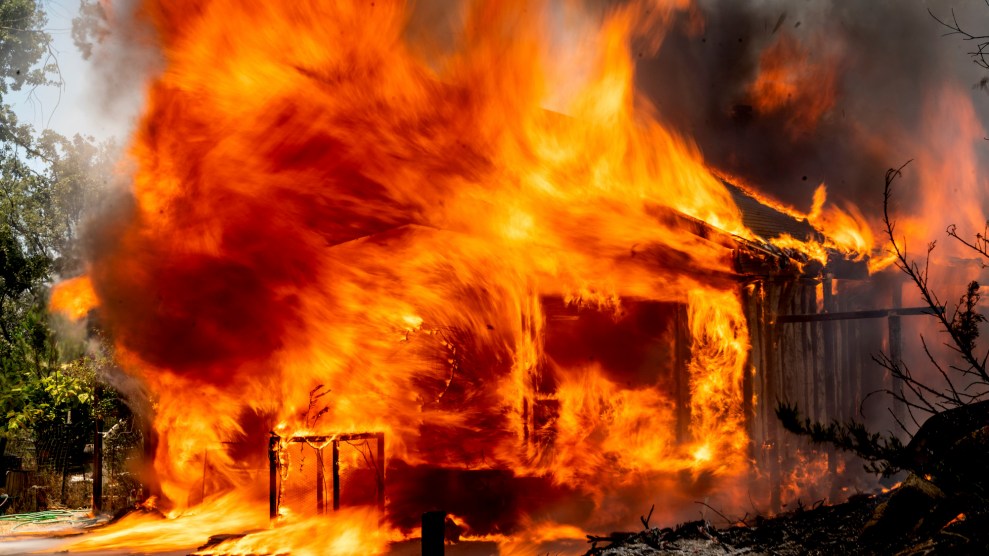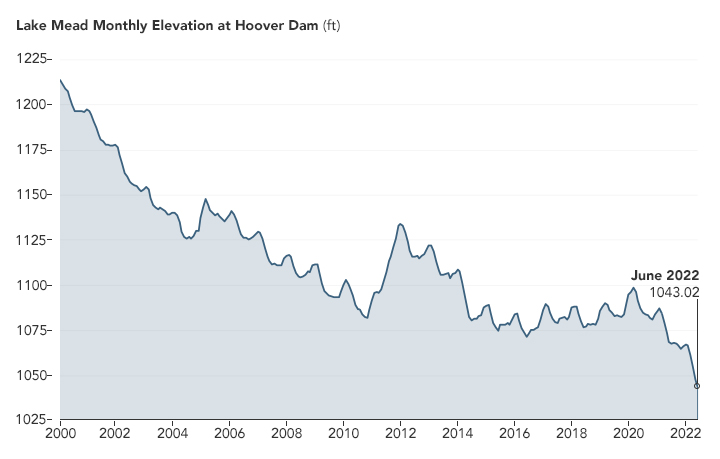
Flames from the Oak Fire consume a home on Triangle Rd. in Mariposa County, Calif., on Saturday, July 23, 2022. AP Photo/Noah Berger
Over the past six months, prospects for serious federal action on climate change have dimmed. Sen. Joe Manchin (D.-W.V.), a literal coal baron, wields de facto veto power over federal legislation, and he has repeatedly used it to whittle down and ultimately kill President Joe Biden’s once-ambitious climate agenda. Reeling in the polls, Biden himself has declined to publicly hector Manchin to change course, instead busying himself boasting about falling gas prices and pleading with Saudi Arabia to ramp up oil production. With the midterm elections—and the real possibility of losing Democratic control of Congress—looming in November, the president declined to declare a formal climate emergency, as several prominent Democratic politicians had urged him too. Instead, he vaguely promised executive action “in the coming weeks.”
My message today is loud and clear: Since Congress is not acting on the climate emergency, I will.
And in the coming weeks my Administration will begin to announce executive actions to combat this emergency.
— President Biden (@POTUS) July 20, 2022
While the administration’s policy experts debate what precise actions to take, a look west to California, the nation’s most populous and agriculturally productive state, might prove a bracing way to focus their attention. Here are a few climate-related developments from the Golden State:
• In sharp contrast to recent summers, California’s 2022 fire season got off to a mercifully slow start, a surprise given that the state was mired in the third year of an historic drought. That changed Friday, when a blaze erupted in Mariposa County, at the edge of the Sierra Nevada mountain range. Deemed the Oak Fire, as of Sunday afternoon it was still “0% contained, according to the state’s fire agency, which warned of weather that’s “expected to remain hot with minimum humidity between 5 and 10%, which will hamper firefighting efforts.”
Here’s Fresnos ABC affiliate, KSN:
As the fire spreads, forcing thousands of people to evacuate their homes, hazardous levels of smoke have descended upon Yosemite National Park.
This smoke projection from the High-Resolution Rapid Refresh computer model depicts heavy smoke from the #OakFire moving westward over Yosemite National Park this afternoon. Downslope winds will push heavy smoke into the Sierra Nevada foothills tonight. #CAwx #Firewx pic.twitter.com/ys3ZliOc0e
— NWS Hanford (@NWSHanford) July 24, 2022
• While fires engulf the mighty Sierra Nevada mountain range’s bone-dry forests, yet another year of paltry snow accumulation is causing all manner of trouble. Mono Lake, in the Sierra foothills just east of Yosemite, has long been a symbol of the state’s environmental dilemmas. Here’s The San Francisco Chronicle:
For eight decades, the city of Los Angeles has piped water from four creeks that feed the lake to its facilities 350 miles to the south, sometimes diverting almost all of the inflow. It’s a familiar California tale of old water rights yielding inordinate benefit.
In 1994, a movement to save the lake resulted in strict limits on how much water Los Angeles could grab from Mono. Now its main threat is climate change. “Amid a third year of drought, the sprawling lake on the remote east side of the Sierra Nevada is sharply receding, and the small towns and wildlife so closely tied to the water are feeling the pinch,” The Chronicle reports. The consequences are dire.
Already, parts of the lake popular with kayakers, beachgoers and tribal members have dried up. Fierce dust storms blow off the exposed lake bottom and cloud the skies with some of the nation’s worst air pollution. A land bridge is forming to islands with tens of thousands of nesting gulls, threatening to bring coyotes within easy reach of baby birds.
• That same phenomenon—a succession of failed winter snowpacks in the Sierra Nevada range—is also putting severe pressure on farm operations in the Central Valley, source of 40 percent of the US food supply. In the increasingly rare years of bountiful snowpacks, the bulk of the resulting snowmelt is shunted into dams and canals that irrigate the valley’s farms. This year, those canals are dry, pushing farmers to draw from wells tapped into rapidly depleting underground aquifers. On top of water scarcity, they’re facing near-record-high temperatures.
Today will be the 14th consecutive day of triple digit heat in Fresno and Bakersfield. Triple digit heat is likely in most of the San Joaquin Valley Monday afternoon. #CAwx pic.twitter.com/uK7JROEg6A
— NWS Hanford (@NWSHanford) July 24, 2022
• The Sierra Nevada isn’t the only mountain range that feeds water to California’s cities and farms. Snowmelt from Colorado’s Rocky Mountains runs into the Colorado River, which in turn supplies water to much of Southern California’s cities, as well as the agriculture-dominated Imperial Valley, a major source of winter vegetables for the United States. NASA recently delivered dire news on the state of Lake Mead, the vast Colorado River-fed reservoir.
Continuing a 22-year downward trend, water levels in Lake Mead stand at their lowest since April 1937, when the reservoir was still being filled for the first time. As of July 18, 2022, Lake Mead was filled to just 27 percent of capacity.
The largest reservoir in the United States supplies water to millions of people across seven states, tribal lands, and northern Mexico. It now also provides a stark illustration of climate change and a long-term drought that may be the worst in the US West in 12 centuries.
This NASA image shows the rapid decline of one the most important US water resources.

And this chart tells the same sad story.














